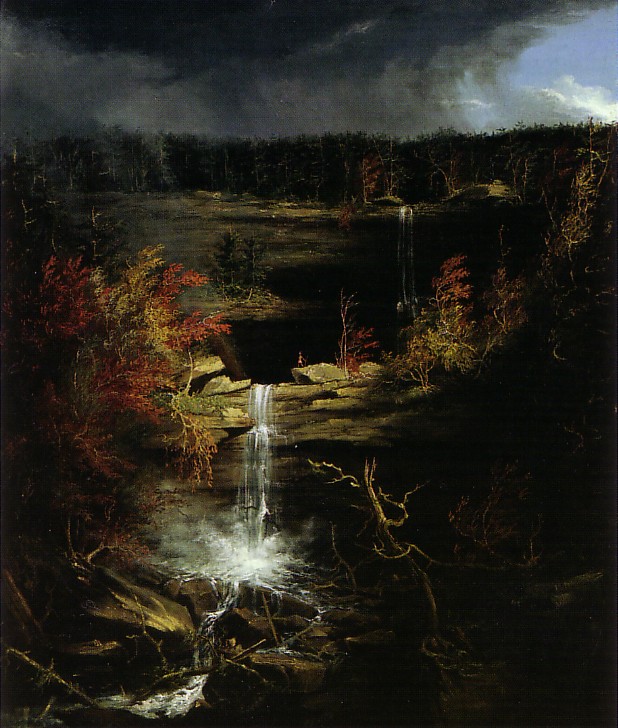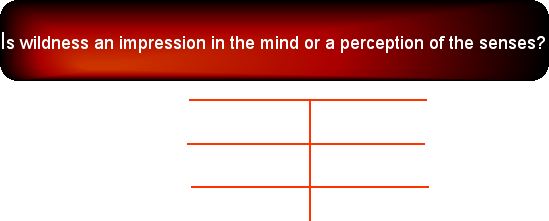 wildness
wildness Navigating the site:
How does defining "wilderness" pose a problem for us?
condition | question | answer | dispute | conclusive argument | our national stake in the answer | three facets of wilderness
Thomas Cole, Katterskill Falls painted scene of the Catskill Mountains: a vision of the continent's wild quality.
Nash says that with wilderness:
"The difficulty is that while the word is a noun it acts like an adjective."
p. 1.
Colonial heritage | etymology | dichotomy | related subjects | summary
Don't other words mean two things with no, less, or little difficulty?
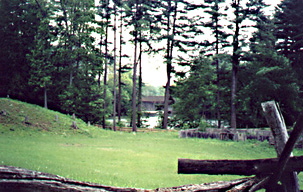
Pastoral scene from Old Sturbridge Village, Massachusetts. Such farms reinforced a vision of small town, rural virtues.
By defining wilderness as an absence of urban or civilized or pastoral conditions, do we --in the end-- have a less than satisfactory description?
"Tocqueville, . . . was correct that 'living in the wilds' produced a bias against them."
Nash, p. 43.
"Prejudice against wilderness had the strength of centuries behind it and continued to influence American opinion . . . . this darker background of repugnance . . . ."
Next.
Outside and Uptight: Examining the Buttoned-down Mind (1950s)
| Question | ||
|---|---|---|
| Impression in the intellect | a sensory experience of isolation | |
| unsettled area that remains untamed | no areas are truly untouched by humans | |
| culturally determined obstacle or asset | ecology, not ego is the decisive arbiter of wild | |
| necessary for our psychological health to nourish sanity. | we need to get over it; the sensory illusion is cognitively debilitating. | |
"Understandably, subjugation of wilderness was the chief source of pioneer pride. Indeed the whole nation considered the settlement of the West its outstanding accomplishment."
Nash, p. 42.
Two views of our cultural landscape heritage:
| Nash | Pollan |
| no to few human signs of intervention | evidence of intent & intervention |
| "we need this tonic of wilderness" | Area unaffected by humans does not exist. |
Roderick Nash first published a slimmer volume of Wilderness and the American Mind, in 1967.
Next.
“Why Wilderness?”
By Roderick Frasier Nash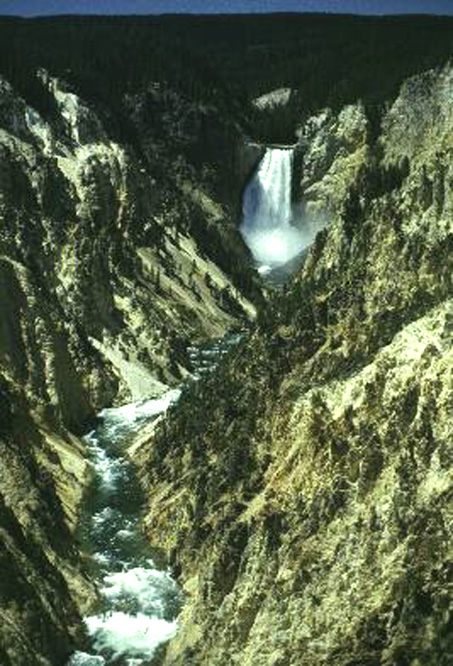
Summary: Nash believes that it is essential to preserve what he calls wilderness. Wilderness as he defines it is a large area of nature that shows no signs of human intervention. He suggests seven reasons “why wilderness” should be preserved.
- Scientific value,
- Spiritual value,
- aesthetic value,
- heritage value,
- psychological value,
- cultural value, and
- intrinsic value
These seven "virtues" comprise Nash’s list of justifications for natural preservation with respect to wild areas, wilderness and the native wildlife. He concludes with the idea that we must act now on preserving what has been left untouched.
Next.
Science was called natural history and philosophy.
Three lives to assist us in "seeing" what Colonial thinkers saw, recorded and examined around them.
Mark Catesby,
Catesby, Mark. The Natural History of Carolina, Florida and the Bahama Islands. 1731-45.
Mark Catesby, an English-born artist-naturalist, embarked in 1712 on two scientific expeditions to the southern colonies of British North America. 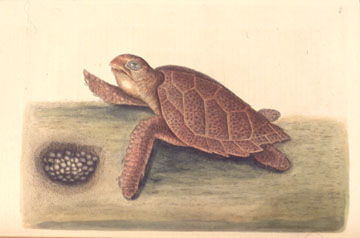 These journeys would ultimately result in the first major work on New World botanical and animal life, The Natural History of Carolina, Florida and the Bahama Islands.
These journeys would ultimately result in the first major work on New World botanical and animal life, The Natural History of Carolina, Florida and the Bahama Islands.
Too poor to hire engravers, Catesby personally translated his watercolors into 220 plates of birds, reptiles and amphibians, fish, insects, and mammals. Volume I was published in 1731, Volume II in 1743, and the Appendix in 1748. In addition to the plates, Catesby included descriptions of plants and animals, soils, climate, agriculture, and Indians.
Cadwallader Colden was a noted 18th century physicist, botanist, merchant, physician, and historian who also compiled astronomical tables and wrote on psychology, mathematics, cancer and yellow fever. Colden arrived (1710) in Philadelphia to practice. He moved (1718) to New York, where he was appointed (1720) surveyor general. He was named (1721) to the governor's council and became increasingly influential during the administration of George Clinton (1686-1761), the colonial governor. After 1761 he was lieutenant governor of New York. Colden was also one of the most erudite men in the colonies.
He is generally cited as the author of the first scientific texts published in the colonies, and his better-remembered works include an attempt to expand on the work of Isaac Newton, and a finding that filth and foul air had been contributing factors in an epidemic that swept New York City. Colden wrote a history of the five nations of the Haudenosaunee League (Iroquois: The Six nations' League), native to upstate New York.
He corresponded with Karl Von Linne, or Carolus Linnaeus and was a friend of Benjamin Franklin, until politics drove them apart. He served as surveyor-general and later as Governor of the province of New York (though Lieutenant Governor was his official title). He surveyed the Mohawk Valley, later territory through which the Erie Canal was planned and dug.
In his public posts Colden was strictly loyal to England. When he announced in 1763 that he would enforce the Stamp Act, he was first burned in effigy, then imprisoned by the New York City Council until he agreed not to collect the hated tax.
One result of this incarceration was that he became disdainful of proposals for democracy, equating it with mob rule. He was the featured speaker at the Manhattan unveiling of a statue of King George III, and in another controversy, he ordered a political opponent, one Alexander McDougall, to be arrested and charged with seditious libel.
Colden was the earliest user of the Linnean binomial classification system of plants and animals in the English colonies and lived for a time in Newburg, New York --on the frontier-- beside the Hudson River before moving to Flushing Meadows. He knew Edmund Haley, who read one of Colden's papers to the Royal Society.
Timothy Dwight (1822)
"The conversion of a wilderness into a desirable residence for man at least may compensate the want of ancient castles, ruined abbeys and fine pictures."
"The conquest of the wilderness bolstered the national ego."
Nash, p. 42.
“The Idea of a Garden”
By Michael Pollan
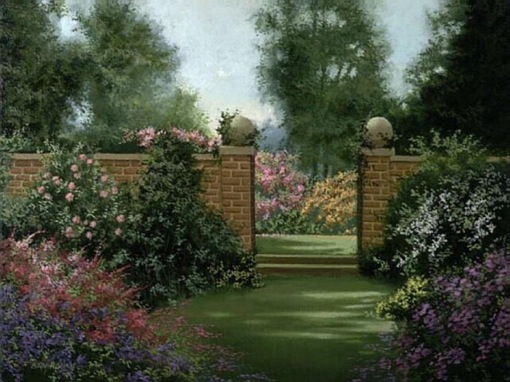
Summary: Pollan begins with a story on how a tornado ruins
a perceived original forest. Afterward, purists, townies, and entrepreneurs
conflict over what should be done for the future of the forest. Pollan
argues that a natural wilderness that has not been affected by humanity
doesn't exist. He believes that as humans our duty can best be paralleled
as seeing the forest as a garden and humanity as the gardener.
The argument over wilderness goes to the very identity, integrity and value of America' natural heritage:
| untouched by civilization | tampered landscape | |
|---|---|---|
| direct | ||
| indirect |
?
| Preservation | Conservation | |
|---|---|---|
| vision | qualitative: defined in part by past references. | quantitative: defined by future needs. |
| goal | hold in trust to appreciate meaningful episodes of a previous legacy. | keep from harm loss or decay. |
| implementation | the perpetual safeguarding of treasures that reveal lessons for our civilization, culture, or history. | wise use for the greatest number for the greatest good for the longest time. |
| proponents | John Muir, George B. Grinnell, Mardie & Olaus Murie | Gifford Pinchot, W. J. McGee, Theodore Roosevelt, Richard Ballinger* |
* Gifford Pinchot, then Forest Service chief, W. J. McGee ("the brains behind the conservation movement"), and Theodore Roosevelt, split the Republican Party over Secretary of Interior Richard Ballinger's leasing of federal lands for oil and mineral exploration in 1910-12, leading the Roosevelt's decision to run against William Howard Taft (traditional, Ohio, Republican) for the Presidency as the "Bull Moose" Progressive Party candidate in 1912.
What are we as a people who settled and transformed a continent, sought refuge from intolerance, and had faith in the justice and equality that is the promise of the New World?
Integrity,
Politcally, progressive precedents created, funded and maintained in a bipartisan tradition: national wildlife refuges, conservation, the Forest Service, the Park Service, and the Reclamation Service to retain America's prototypical natural features, fisheries, wildlife and resources.
Value,
The watershed's protection, the wildlife reserves, the controlled burns (fire-ecology), and the need for field research areas are of both economically commercial and of economically marginal worth depending on the dependence of nearby settlements on the surrounding, shared features of the countryside, its topography and climate.
Next.
What are the three facets of wilderness?
- linear - 1-D: the origin of the word as denoting uncultivated, raw, untamed.
- aerial - 2-D: the cultural talisman or symbol o of the substance by which we are tested and made.
- volumetric - 3-D: the places where natural selection largely shapes the populations of fisheries & wildlife.

